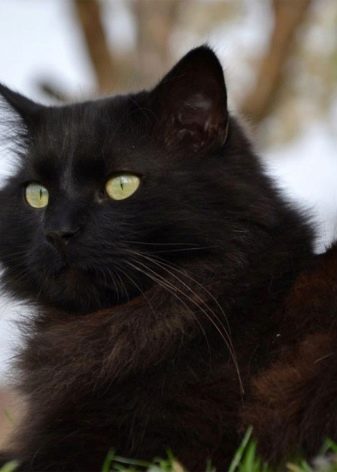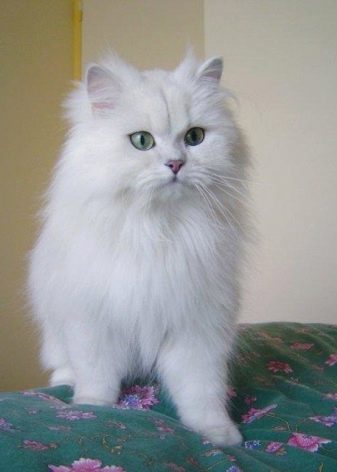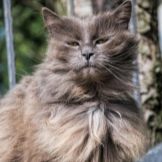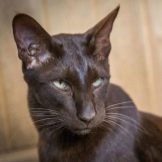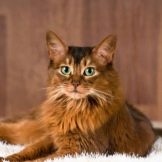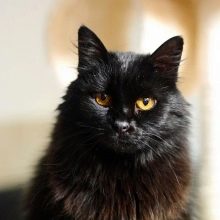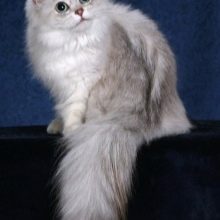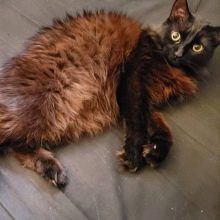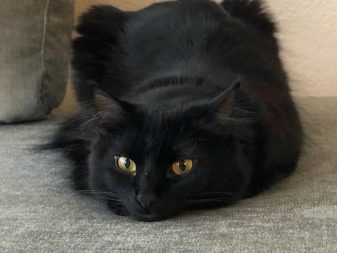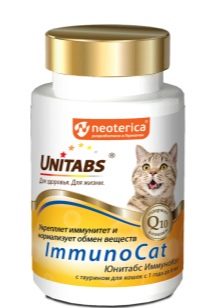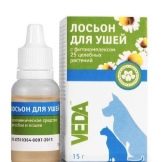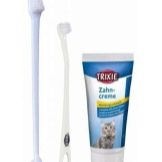Chantilly-Tiffany is a representative of long-haired cats. Pet lovers will be fascinated by the beautiful character, sharp mind and its indescribable beauty. Cats of this breed get along well with children and other pets, which is another plus. Let us today take a closer look at Chantilly-Tiffany, learn the history of origin, its differences from other cats, as well as features of care.
History of origin
At the first stages of breeding, professional breeders did not breed this breed. It all started quite unusual. Once Jenny Robinson, who lived in New York, went to a pet store near the house. They found a couple of wonderful chocolate-colored kittens and different sexes. The woman immediately acquired both, gave them the names of Shirley and Thomas. When the kittens reached the age of puberty, they gave birth to offspring, exactly the same color as the parents. Then Jenny Robinson continued her work and after a few years she had a rather extensive feline family.
Miss Robinson understood that her knowledge was not enough to further breed. She began searching for a professional felinologist. The choice fell on Sigi Lund, who owned a vast kennel, was bred by Burmese cats. This wonderful woman continued the work of her predecessor. The breeder first presented kittens at a major show in New York in 1979, where they were present under the name "foreign longhair cat".
Visitors were fascinated by the new breed, the organizers also did not hide their enthusiasm. However, representatives of the international association of cats demanded to change the name. After brainstorming among nursery workers, a new name was chosen, and the Chantilly-Tiffany breed was born. Then work began on the official recognition of the new breed of cats.
Soon there was information that Chantilly-Tiffany is one of the varieties of Burmese cats, which means that the new breed was not bred. This dealt a huge blow to Siji Lund's vanity, and after several trials she completely stopped working on the Chantilly selection. Only a few years later, work was resumed, but by a resident of Canada, Tracy Oraas. She had a lot of work to collect evidence about the absence of a common ancestor of the Burmese cats and Chantilly-Tiffany. In the end, she succeeded; she registered her pets in almost all world cat associations.
After that, Tracy Oraas decided to diversify the color of their favorites. Breeds such as were brought:
- Nibelung;
- Havana;
- Somalia;
- Angora
Thanks to them, they managed to diversify the colors of Chantilly wool, while their individuality was not lost. Today, this breed is bred mainly in the United States. There are very few nurseries in Europe, but in Russia there are none at all.
Therefore, the price of one kitten reaches 500 y. e., and that is without transportation.
Description
Representatives of this breed have a long wool, which does not stray into mats. The standard color is considered chocolate or black, but can be white, blue, smoky, purple. In itself, the animal is slender, elongated body, strong, muscular tissue is well developed. However, all this is hidden under a thick layer of wool, which creates a deceptive feeling of a large build. The weight of cats does not often exceed 5.5 kg.Female representatives are usually smaller than cats.
The limbs of Chantilly-Tiffany are long, sophisticated, stable. The muscles of the legs are developed, and the pads on the feet are round and soft. The tail is quite long and fluffy. The head is small, when compared with the body, has the shape of a wedge, the forehead is rounded and wide, but the chin is quite strong. The cheeks do not stand out, the mustache is long and well defined. In profile can be seen a slight bend. Ears seem small, widely spaced. Only this appearance due to thick and long hair. In fact, the shells are large, located rather deeply at a considerable distance from each other with a slight slope. The tips of the ears are rounded.
The eye section is oval or almond-shaped, they are wide open, rather large. Eye color has all shades of brown and gold. The eyes are very vulnerable, as a large amount of tear fluid is expelled every day, therefore daily care is required. Luxurious and long wool - the main advantage of the breed. She does not fall down into mats, does not get dirty, there is no undercoat.
There is a small feature in its length - it is much longer in the neck and hind limbs.
Character traits
Kittens of this breed are very active and inquisitive. They do not sit still for a minute, they play all the time. Their minds are very lively, they easily and quickly get used to the tray, they begin to understand what is allowed and what not to do. They are very easy to find a common language with children and other pets. In games with younger members of the family, they show tolerance and never use their claws.
Although Chantilly-Tiffany plays with the whole family, she usually chooses one host for herself, whom she obeys and respects more than others. Adult representatives of the breed continue to play and frolic, but some slowness and laziness appear in them. Increasingly, they can be caught on the windowsill, basking in the sun.
They do not like to stay at home alone, they often begin to trickle, so it is best to start Chantilly-Tiffany for those families that have someone constantly at home.
Feeding
Remember that domestic cats are very inclined to be overweight and overeating, therefore It is necessary to carefully monitor the frequency of meals, which should not exceed 2 times a day. Choose food that your pet likes.
Be sure to make sure that the food matches the age of the kitten, which will allow you not to worry whether your pet is eating or not. Some breeders claim that cats eat dry food well, others say that natural food is preferable. It should be remembered that with completely natural food, it is necessary to periodically introduce vitamins, trace elements, vegetable fibers in the form of raw herbs or a special supplement from a veterinary pharmacy into the diet.
The basis of the diet for breastfeeding should be lean meat, sea fish, eggs. The menu should be diluted with cereals, for example, buckwheat, barley, vegetables (zucchini, carrots). It is not necessary to give cats starchy vegetables, such as potatoes, green peas, boiled beets. Chantilly-Tiffany's favorite delicacy is fruit.
But with pastry you need to be very careful, as pets quickly get used to them. They begin to demand delicacy, as a result of which they quickly gain weight.
Conditions of detention
Surprisingly, this breed has good health, excellent immunity. Life expectancy is about 15–18 years. Chantilly-Tiffany does not require special conditions of detention. A spacious apartment, a tray with a good filling, two bowls (one designed for water, the other for food). Do not choose plastic dishes, best of all, if it will be iron products. It is necessary to feed the cats 2 times a day, but the water should be changed as often as possible. Use only wet, filtered liquid. Do not use boiled water in any case.
Every year, take your pet to the vet for an examination. Do all the required vaccinations in a special room. You should not do it yourself, because you can not assess the level of health of your pet, helminth contamination. Vaccination may be delayed if the animal is infected with parasites or deworming carried out in the coming month.
It is necessary to pay attention to several features of care.
- Eyes. A large amount of tear fluid requires particularly careful maintenance. Every day you should wipe your eyes with wadded disks moistened with water or infusion of tea leaves. For each eye, use a separate swab. With the appearance of nitrous oxide, eye abscesses, you can use tetracycline ointment. If this does not help in the next few days, be sure to contact your veterinarian. And you should also panic when your eyes are too dry, which indicates a worsening of the outflow of tear fluid.
- Ears. They need to be cleaned about once a week. Use cotton buds, ear cleaning lotion.
- Teeth. Careful oral care will prolong the health of your pet. It is necessary to teach a cat to this procedure from a very young age. Then the kitten will understand that although it is unpleasant, but rather tolerable, and at an older age he will not run away from you. Ask for a special device at the pharmacy and gently clean the cat's teeth. If your pet categorically refuses this procedure, purchase a special dry food and give it weekly.
- Wool. We have already mentioned that wool is the main virtue of Chantilly-Tiffany. She does not get dirty, does not fall into mats, does not require daily combing. However, it is still necessary to use the comb during the molting period. Cats are susceptible to eating their fur, which often leads to problems with the gastrointestinal tract. A large ball of wool can cause malnutrition, constipation, nausea. Remember that the frequent urge to nausea, refusal to eat, your pet's lethargy suggests that an excessive amount of wool has accumulated in his stomach.
Therefore, in advance, purchase a wool-dissolving paste at the pharmacy and use it weekly. And also you need to comb your cat during the molting period - the more often, the better. Preferably several times a day.
On what are the rules of care for Chantilly-Tiffany, see the following video.

